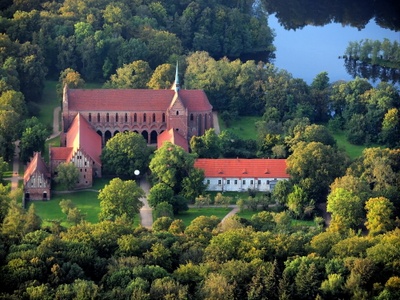
16-18 February 2014, Chorin Monastery, Berlin, Germany
Goals
-
Develop an agenda for innovative co-evolutionary modeling of global society-environment interactions in the Earth system
-
Contribute to a special issue in the journal Earth System Dynamics
-
Take concrete steps towards forming a modeling network
Key participants
- Rainer Hegselmann, University of Bayreuth, Germany (Social dynamics)
- Carsten Lemmen, Helmholtz Institute for Coastal Research, Germany (Paleosocietal dynamics)
- Tim Lenton, University of Exeter, UK (Earth system analysis)
- Petter Holme, Umeå University, Sweden (Adaptive networks and complex systems)
- Johan Rockström, Stockholm Resilience Center, Sweden (Planetary boundaries)
- John Schellnhuber, Potsdam Institute for Climate Impact Research, Germany (Earth system analysis)
- Peter Turchin, University of Connecticut, USA (Cliodynamics)
Organizers
Jonathan Donges (PIK Potsdam, SRC Stockholm), Wolfgang Lucht (PIK Potsdam), Axel Kleidon (MPI BGC Jena), Jobst Heitzig (PIK Potsdam)
Working mode
In the LOOPS 2014 workshop we gathered a carefully selected group of international experts for creatively exploring innovative approaches to Earth system modelling. The aim was to stimulate collaboration on research questions and model development related to the role of human societies in the Earth system and global societal-environmental co-evolutionary dynamics.
The workshop featured focussed and inspiring short presentations by the participants that fed into joint work on developing concrete papers on Earth system modelling, global change, planetary boundaries and next steps in modelling, for a dedicated Special Issue in the journal Earth System Dynamics, titled Social Dynamics and planetary boundaries in Earth System Modelling. All participants were asked to prepare abstracts on specific research questions related to their expertise before the workshop to provide a basis for collaborative work and discussions during the meeting. A calm setting close to the Chorin Monastery and ample time dedicated to this working mode facilitated the formation of interest groups designing research papers or opinion pieces to be finalized after the workshop.
Scope
Human actions play an increasing role in shaping the Earth’s planetary environment, from the physical climate system to biogeochemical cycles to the functioning of the land surface. To understand and predict the future evolution of the Earth system, it is thus critical to map the safe operating space for humanity, as well as to study socio-economic dynamics and their interactions with climate, and the consequences for the planetary system. There is a range of urgent questions related to this topic, from the definition of planetary boundaries, tipping points, thresholds and critical transitions in the global socio-environmental system, and the identification of sustainable pathways for future development.
However, the current Earth system modelling landscape lacks the tools to adequately address these challenges. Either societal dynamics are tightly constrained by economic optimization paradigms (Integrated Assessment modelling) or are present only as prescribed scenario input (physical Earth system models, such as those participating in the CMIP5 intercomparison project). Furthermore, feedback loops between social and environmental processes are largely absent in current Earth system models.
To address this gap in the modelling landscape, what is needed is a more dynamic societal sphere allowing for social tipping points, major reorganizations, revolutions and collapse in conjunction with a description of the fully coupled co-evolutionary dynamics of human societies and the natural Earth system. For the LOOPS 2014 workshop, we sought novel and innovative approaches for modelling socio-economic phenomena in the Earth system, their dynamics, interactions, and boundaries.
To facilitate this process, we called for contributions applying concepts and methods that included, but were not limited to the following fields:
-
Earth and social systems thermodynamics and stoichiometry (e.g., socio-industrial metabolism)
-
Socio-ecological systems modeling
-
Conceptual, empirical, or agent-based models from the social sciences
-
Adaptive and temporal networks
-
Dynamical and evolutionary game theory
Inspiring literature
-
Gross, T., and B. Blasius (2008). "Adaptive coevolutionary networks: a review." Journal of the Royal Society Interface 5: 259-271.
-
Kellie-Smith, O., and P. M. Cox (2011). "Emergent dynamics of the climate–economy system in the Anthropocene." Philosophical Transactions of the Royal Society A: Mathematical, Physical and Engineering Sciences 369.1938: 868-886.
-
Lenton, T.M., H. Held, E. Kriegler, J.W. Hall, W. Lucht, S. Rahmstorf, and H.-J. Schellnhuber (2008). “Tipping elements in the Earth's climate system”, Proceedings of the National Academy of Sciences 110: 10324-10329.
-
Rockström, J., et al. (2009). "A safe operating space for humanity." Nature 461: 472-475.
-
Schellnhuber, H.-J. (1999). "Earth system analysis and the second Copernican revolution." Nature 402: C19-C23.
-
Schlüter, M., et al. (2012). "New horizons for managing the environment: A review of coupled socio-ecological systems modeling." Natural Resource Modeling 25: 219-272.
-
Turchin, P.,T. E. Currie, E. A. Turner, and S. Gavrilets (2013). "War, space, and the evolution of Old World complex societies." Proceedings of the National Academy of Sciences 110: 16384-16389.





